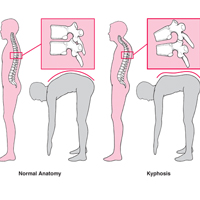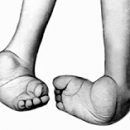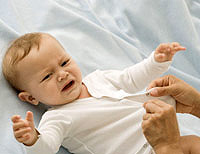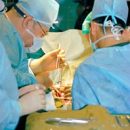Healthy spine has several bends. Physiological bending in the thoracic department is called kyphosis. Most often kyphosis is a pathological deformation of the spine. Cyphos treatment depends on the cause of deformation.
Content
The concept of kyphosis
Healthy spine has a physiological bending of an inflation, called - kyphosis. Normally bending is 20°C-45°WITH. However, the term kyphosis is more often used to designate the pathological deformation of the thoracic spine - increased kyphosis or hyperkiposis.
There are several types of kyphosis:
- Postural or nonstructural kyphosis
- Kyphoz Schoyerman - Structural
- Congenital kyphosis
- Osteoporotic kyphosis
 Poshared or nonstructural kyphosis, the most common type of kyphosis, characterized by a sutural, irregular posture and a rather movable spine, with an increased natural bend. At the request of the patient, straighten up - kyphosis decreases. Usually manifests itself in adolescence, more often in girls.
Poshared or nonstructural kyphosis, the most common type of kyphosis, characterized by a sutural, irregular posture and a rather movable spine, with an increased natural bend. At the request of the patient, straighten up - kyphosis decreases. Usually manifests itself in adolescence, more often in girls.
Postural kyphosis is rarely accompanied by pain, exercises for strengthening the muscles of the press and stretching Hamstrings (popliteal tendons) help reduce the associated discomfort. With age, this type of kyphosis usually does not bring additional health problems. Radiographic changes of the vertebrae are not observed.
Schoiberian kyphosis - structural like early kyphosis, Kyphos Schoiberman manifests itself more often in adolescents (the boys suffer twice as much as girls) especially in thin children. The angle of deformation is sharper and most pronounced with lateral inspection, during flexion.
The deformation affects mainly the chest spine, although rarely manifests itself in the lumbar department. Pains are localized on top of deformation, which increase with activity, as well as with a duty of standing or seat. When X-ray examination, there is a change in the form of the vertebrae - the characteristic wedge of bodies and narrowed intervertebral prostations. Often accompanied by scoliotic spinal deformation - kifoscolyosis.
Congenital kyphosis manifests itself in newborns who have a spine in the process of intrauterine development began to develop with deviations, for example, a few vertebrae, or underdevelopment of the vertebra (semi-non-television). In most cases, surgical treatment is required in early childhood, which allows to preserve the more physiological form of the spine. However, permanent monitoring of any changes in the process of growing the body is required. Additional examination is needed using magnetic resonance to make sure that the deformation does not squeeze the spinal cord.
Osteoporous kyphosis manifests itself with age when compression sedans appear, vertebral fractures on osteoporosis.
Cause and symptoms of kyphosis
Kyphosis can develop as a result of injury, abnormalities for the development of vertebrae, degenerative diseases. Cause Kihosa Schoyerman Unknown. Other reasons for kihosis - tuberculosis, neurofibromatosis, muscle dystrophy, neoplasms, disk degeneration, etc.
The main symptoms of KIFOS:
- discomfort, minor back pain
- Tired
- Standing back
- Sutulya postancay
- Difficult breathing (in severe cases)
Treatment of kyphosis
Cyphoz treatment depends on the cause of deformation. Postural kyphosis improves, therapeutic physical culture helps reduce discomfort or pain associated with incorrect posture. At Kyphos Schoyerman, conservative treatment includes a special exercise program and anti-inflammatory medicines for pain. If the growth is not over and there is a risk of deformation progression, the corset is assigned to which the patient uses to the final maturity of the skeleton. Osteoporous kyphosis requires specific medication to prevent subsequent fractures.
Surgical treatment is recommended if the magnitude of the pathological kyphosis exceeds 60° For correction and stabilization of the bend of the spine. With osteoporotic kyphosis, surgical treatment is required if there are neurological symptoms or pronounced pain. In congenital kyphosis, the pathological vertebra is removed to release the spinal cord from compression and adjust the deformation.
The main objectives of the operation:
- Reducing the degree of deformation, fixation and splicing spine segments
- keep the achieved effect for a long time
- reduce significant pain and discomfort if those were present before the operation









